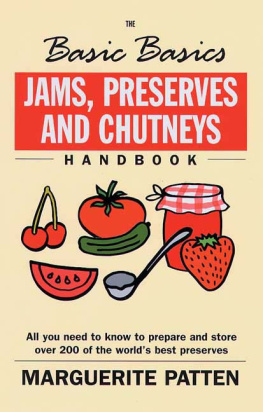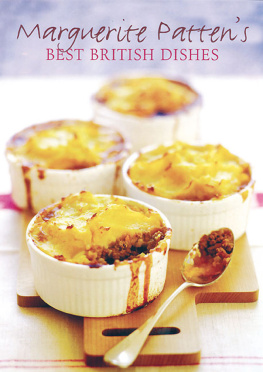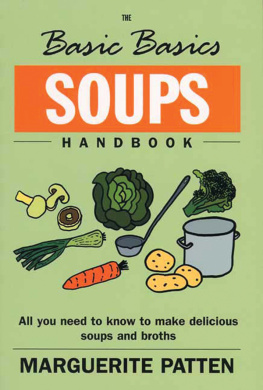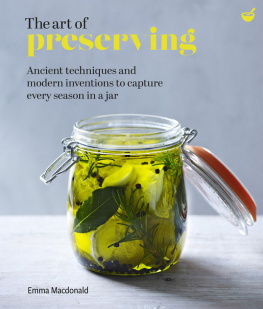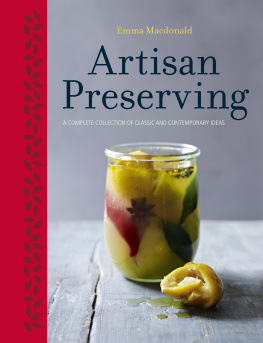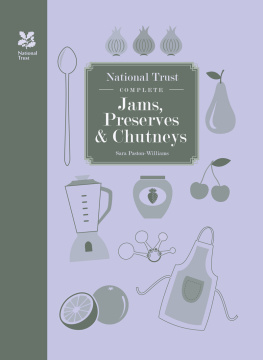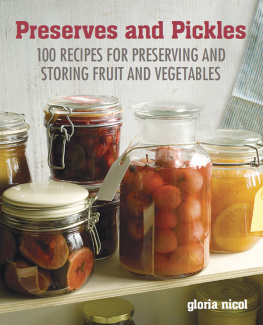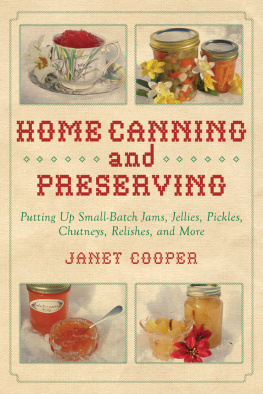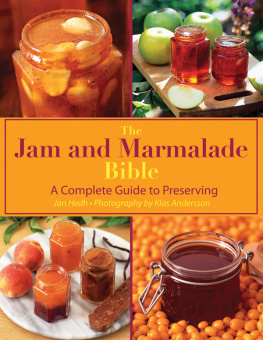
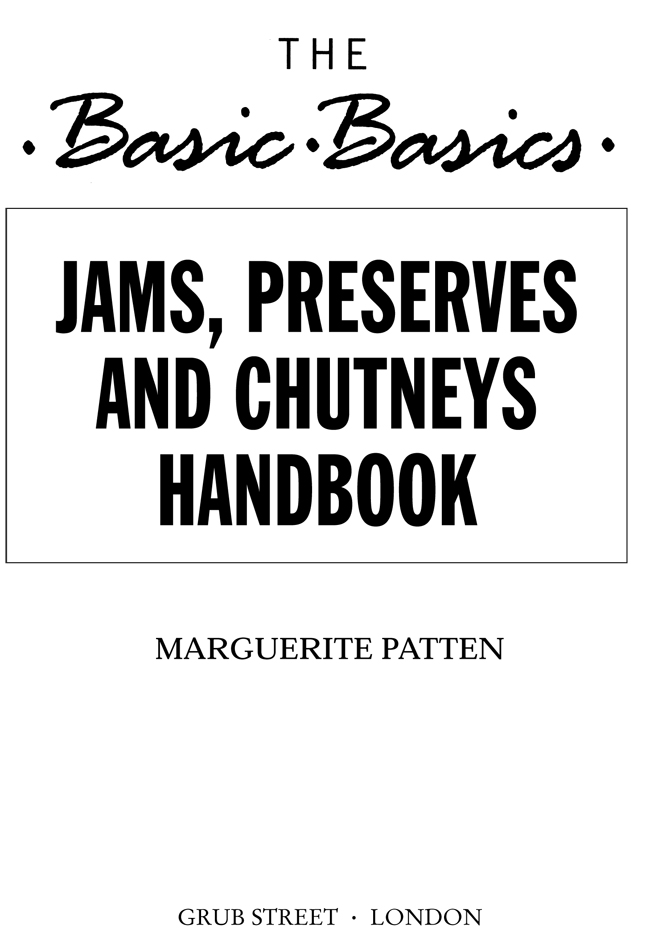
This new edition published by Grub Street
The Basement, 10 Chivalry Road, London SW11 1HT
Copyright this revised edition Grub Street 2001
Text copyright Marguerite Patten, 1995 and 2001
First published in 1995 by Bloomsbury Publishing Plc
The moral right of the author has been asserted.
British Library Cataloguing in Publication Data
Patten, Marguerite
The basic basics jams, preserves and chutneys
1. Cookery (Jam) 2. Canning and preserving 3. Chutney
I. Title II. Jams, preserves and chutneys
641. 852
ISBN 1-902304-72-1
Digital Edition: ISBN 9781908117731
All rights reserved. Apart from any fair dealing for the purposes of
private study, research, criticism or review, as permitted under the
Copyright Act, no part of this book may be reproduced or transmitted in any
form or by any process without permission in writing from the publisher.
Typeset by Pearl Graphics, Hemel Hempstead
Printed and bound by Biddles Ltd, Guildford and Kings Lynn
I would like to acknowledge the helpful information about certain fruits in the following two books:
The Complete Book of Fruit, Leslie John and Violet Stevenson, 1979, Angus and Robertson.
The Fresh Fruit Cookbook, Vo Bacon, the Department of Agriculture, New South Wales, Australia.
INTRODUCTION

T hroughout history we can read of efforts made to preserve food for use in winter. In the case of meats and fish this was done by salting or drying. Fruits and herbs were dried too. People preserved certain fruits in brandy and pickled suitable vegetables in vinegar. These preserves are excellent and the recipes are on pages 138 to 159.
Cane sugar, although known as a scarce luxury in the Western world since the fourteenth century, did not become a major food in Britain until the nineteenth century. Beetroot was a well-known vegetable but it was not grown for its sugar content until the discovery made by A. S. Marggraf in 1747. He realised that the sugar content of beet is similar to that of sugar cane. When sugar became plentiful, cooks could use it for all forms of cooking, which led to the development of preserving as we know it today. Fruits and vegetables of all kinds could be turned into delicious jams, and other produce, which were made for storage.
It was in Victorian and Edwardian times that great pride was taken in having plentiful stores of preserves. Housewives depended upon their own resources and filled capacious larders and store cupboards with their home-made handiwork. Cookery books of that era abounded with recipes for jams, jellies and catsups (known nowadays as ketchups) together with chutneys and pickles of all kinds. Many of the recipes we use today are similar to the ones created in those faraway days. Thanks to the popularity of ethnic foods and various restaurants we have had the chance to sample preserves from all around the world, some of which are classics in their own countries. Fascinating recipes from abroad are included in this book.
Nowadays, with smaller houses and less storage space, together with the availability of commercially made preserves, huge stocks of the home-made variety may not be required, but there are few things that give one more pride and pleasure than carefully selected home-made jams, pickles or other foods. You can choose just those fruits or vegetables that please you most and base your preserves on them. With the wonderful range of exotic fruits and vegetables brought into our country nowadays it is possible to make chutneys, pickles and jellies, etc., which may not be on sale.
Home-made products, if made correctly, generally have a better flavour than those produced commercially in large quantities and, in consequence, have a great appeal. As many readers will know, jars of home-made preserves make wonderful presents and they are an excellent way of raising funds at charity bazaars they can even become a source of income. If one compares the cost of making preserves at home with the cost of buying them, you realise that you can save an appreciable amount of money and, at the same time, produce preserves that have a finer flavour, made just as you would like them. This means that you can retain large, chunky pieces of fruit by preparing conserves, rather than jams, or sieve the fruits to make old-fashioned traditional fruit cheeses, free from pips or stones and skins.
There is great emphasis today on reducing the amount of sugar we eat. However, it must be appreciated that sugar is a very important ingredient when making jams or similar products: it is the preservative. If you reduce the sugar content in the preserves, they will not keep well if stored under normal conditions. There are, however, ways of making low sugar preserves that will keep, either by sterilizing the jars when filled or by placing them in the freezer. These methods are described on page 15.
Preserves have to be made with care. There must be a correct relationship between the amount of fruit and sugar used, or sugar and vinegar in the case of chutney, to give the best flavour and texture and to make sure the preserves set and keep well. This is why it is important to read through the advice given at the beginning of each section, which sets out the golden rules for that particular kind of preserve.
Bottling of fruit and vegetables is less popular today due to the success in freezing these ingredients. There are, however, certain foods, such as peaches and pears, which have a better flavour when they are bottled. Details of this method of preservation are given on pages 124 to 126.
The following pages offer advice on making preserves that will please you and your family and give you a real sense of pride in your achievements.
Marguerite Patten
ESSENTIAL
INFORMATION

In this section the most popular preserves jams, conserves, jellies and marmalades are given. Although the different groups of preserves vary in their requirements, they do have certain points in common.
Equipment: you should choose the equipment you use carefully; that does not mean you need to buy a lot of specialist equipment, for you may already own most of this. It is, however, sensible to read through the suggestions that follow and make sure you have everything in readiness before you begin making the preserve.
Speed of cooking: this is mentioned a great deal in the recipes in this section and it is important that the recommendations are followed. Simmering is essential when cooking the fruit in jams, jellies and marmalades. The speed of boiling when the sugar is added is equally important, see pages 18 to 19.
Testing: it is essential to test for setting point and details of how to test are on pages 8 to 9. These are followed by the method of testing the pectin content of the fruit.
Alternatives to sugar in preserves: sugar acts as the preservative; other forms of sweetening are not as effective but can be used to give a different flavour, see pages 11 and 12.
EQUIPMENT NEEDED WHEN MAKING PRESERVES
Although it is quite possible to make preserves with normal household utensils, it is worthwhile considering purchasing special equipment if you intend to prepare an appreciable amount of jams, jellies and chutneys. The first requirement is a large pan in which to cook the preserve.

